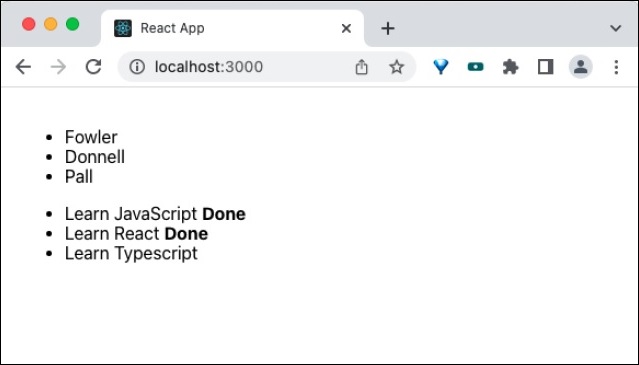由于 react 组件是通过组合(将一个组件置于另一个组件中)而不是通过继承来互连的,因此 react 组件中使用的逻辑不会直接共享给另一个组件。React 社区提供了多种选项来在组件之间共享逻辑,其中一个选项是高阶组件。HOC 本身不是 React API,而是一种没有副作用的设计模式。
在本章中,让我们学习如何使用高阶组件。
如何使用高阶组件
基本上,HOC 是一个函数,它将 react 组件作为输入,然后根据输入组件创建新的 react 组件并返回新创建(包装)的组件。例如,HOC函数可能会接收一个纯数据渲染组件作为输入,然后返回一个新的组件,该组件将具有使用输入组件的数据获取能力和数据渲染能力。
让我们看看如何使用 HOC 并以逐步的方式在两个组件之间共享逻辑。让我们考虑一下从外部 URL 获取和呈现数据的场景。
- 根据功能,使用一个或多个输入参数创建 HOC 函数。
- HOC 函数的第一个参数应该是具有辅助逻辑(例如,数据渲染逻辑)的 react 组件。
- HOC 函数的第二个参数应根据我们的要求进行定义。对于我们的数据获取方案,数据 url 是获取数据的必要信息。因此,我们应该将其作为 HOC 函数的第二个参数包含在内。
- 如果确实有必要,任何数量的参数对于 HOC 函数都可以。
- 在其 componentDidMount 事件中,在 HOC 函数内创建一个新组件,以支持主要逻辑(例如,使用第二个 url 参数的数据获取逻辑)。
- 通过传递从 componentDidMount 事件获取的数据来呈现输入组件。
- 返回新创建的组件。
- 通过组合 DataFetcher (createFetchHOC) 和 Wrapped 组件来创建一个新组件。
- 最后,根据需要在任何地方使用新组件
应用 HOC 组件
让我们通过应用 HOC 组件来创建一个新应用程序。
首先,创建一个新的 react 应用程序并使用以下命令启动它。
cd myapp
npm start
接下来,打开 App.css (src/App.css) 并删除所有 CSS 类。
接下来,创建一个新的 HOC 函数,如下所示 -
接下来,创建一个文件,users.json (public/users.json) 在 public 文件夹中存储用户信息。我们将尝试使用 FetchRenderProps 组件获取它,并在我们的应用程序中显示它。
接下来,创建一个文件,todo_list.json (public/todo_list.json) 在 public 文件夹中存储待办事项列表信息。我们将尝试使用 FetchRenderProps 组件获取它,并在我们的应用程序中显示它。
接下来,创建一个新组件 UserList (src/Components/UserList.js) 来渲染用户,如下所示 -
在这里,我们使用了 data 属性来渲染用户列表
接下来,创建一个新组件 TodoList (src/Components/TodoList.js) 来渲染待办事项,如下所示 -
在这里,我们使用了 data 属性来渲染待办事项列表。
接下来,创建一个新组件 SimpleHOC,通过单个 HOC 组件呈现用户列表和待办事项列表。
在这里,我们有,
- 通过组合 TodoList 和 DataFetcher 组件创建了 UserListWithFetch 组件。
- 通过结合 Users 和 DataFetcher 组件创建了 TodoListWithFetch 组件。
接下来,打开 App.js 并使用 SimpleHOC 组件更新它。
最后,在浏览器中打开应用程序并检查最终结果。应用程序将如下所示 -

总结
高阶组件是在组件之间共享逻辑的有效方法。它被广泛用于许多第三方组件中,具有良好的成功率,并且在反应域中共享逻辑是经过时间考验的方法。



